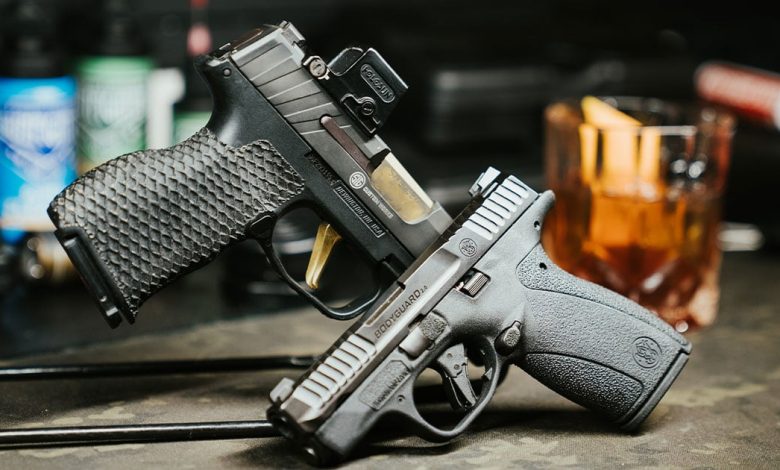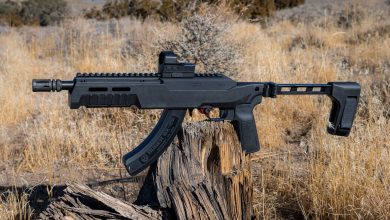The Pros and Cons of Ultralight Carry Guns

I carried full-size handguns in OWB holsters for years during my career, and a good holster with a stiff belt, or even better, a thigh rig, makes carrying a heavy gun easy. But that is not the case when carrying concealed. For one thing, they are bulky, making it more difficult to keep them covered and prevent them from printing. Worse than the bulk is the weight. A heavy gun with a full magazine can become tiring and uncomfortable to carry all day. This is why compact and micro-compact concealed carry guns are so popular. It is also why manufacturers are going all out to make their guns as light as possible. But while ultralight guns are more comfortable to carry, they also come with some disadvantages.
The Move to Lighter Guns
Back in the 90s, there were not a lot of truly light guns to choose from for concealed carry unless you wanted to risk your life on a cheap Jennings or Raven. The full-size steel 1911, which weighed in at an average of around 35oz (2lbs 3oz), still had a large following. The S&W 4013 Compact weighed 27oz (1lb 11oz) even though it was considered a compact. The all-steel Sig P239 Compact weighed even more at 29oz (1lb 13oz). And those are empty weights, add a full magazine and it was a lot of weight to haul around all day. Even though firearms training great Clint Smith said, “Carrying a gun is not supposed to be comfortable; it’s supposed to be comforting,” the reality is that carrying a heavy gun can be tiring and can be difficult in light summer clothes, especially for women. People wanted smaller, lighter guns for concealed carry.
Glock delivered that in 1988 with the polymer frame Glock 19. Compared to the 1911, the 25-ounce G19 was a lightweight. After the inevitable resistance to a new idea that comes when anything truly revolutionary hits a stable market, the manufacturing rush to lighter polymer frame guns began. KelTec’s tiny P32 pocket pistol, introduced in 1999, only weighs 6.6 ounces. Since it is chambered in the mild .32 ACP, people could shoot it without suffering from painful recoil. For people who wanted an ultralight pistol with a little more punch, Ruger introduced the LCP in 2008. Although chambered in .380 ACP, it still only weighs 9.6 ounces. Other manufacturers have released ultralight guns in 9mm, like the Taurus G3c at 22 ounces and the Sig P365, which comes in at around 18 ounces.
Manufacturers are also offering more lightweight revolvers. Probably the best-known is the Ruger LCR. It is available in everything from the mild 22LR through .38 Special and 9mm all the way up to .357 Magnum. Other manufacturers also offer lightweight revolvers, and all of them keep the weight down by using materials like aluminum and even titanium.
The Physics of Shooting a Lighter Gun
Newton’s Third Law of Motion states, “For every action, there is an equal and opposite reaction.” Firing a gun to propel the bullet out of the barrel is the action, and recoil is the reaction. The 9mm cartridge produces an average of around 350 ft/lbs of muzzle energy when fired. Since a foot-pound is the force of one pound moving a distance of one foot, 350 ft/lbs is the force of 350 pounds moving one foot. That’s quite a bit of energy, considering that you are absorbing it on the very small surface area of your hand. Since several aspects of the firearm’s operation absorb some of that energy, like unlocking the bolt and working the action, you don’t get that entire amount in recoil energy. The amount you do get is further mitigated through factors that include the design and weight of the gun.
Design elements that matter are things like bore axis and alignment Index. Bore axis is the height of the barrel and slide above the shooter’s grip. The lower the barrel and slide above the shooter’s grip, the lower the felt recoil and muzzle flip. The alignment index is how well the centerline of the trigger and centerline of the grip curve align. Hammer-fired guns like the 1911 and Beretta 92 have an excellent alignment index. Because striker-fired guns do not have the extra mechanism a hammer requires, they can have a lower bore axis, but that also moves the trigger lower below the centerline of the grip curve, so they do not have a very good alignment index. This is why a 1911 feels so much more natural to point than a Glock. Both of these factors, as well as the shape and comfort of the grip, affect felt recoil. The one thing that balances it out, no matter how the gun is designed, is weight. The heavier the gun, the more recoil energy it absorbs and the lower the felt or perceived recoil. The lower the perceived recoil, the easier and more comfortable the gun is to shoot. This is why you can shoot a 9mm Beretta 92FS weighing 33 ounces comfortably all day long, but a .380 Ruger LCP Max weighing in at 10.6 ounces gets uncomfortable for a lot of people after only a short time shooting it. The heavy recoil produced by a lightweight gun can be even more pronounced in the case of a .357 Magnum revolver like the LCR that only weighs 17 ounces.
Pros and Cons of Ultralight Guns
Small, lightweight carry guns have some definite advantages that make them attractive. For one thing, they are incredibly comfortable to carry. They are also very easy to conceal. Summers where I live are hot and humid, and I live in shorts and tank tops. I never go anywhere unarmed and only carry 9mm handguns, and that’s not a lot of clothes to work with for concealing a gun, so a small, light gun is a must whether I carry it in an IWB holster or drop it in my pocket. Small light guns are especially handy for women because of the way they dress compared to most men.
On the downside is the extra felt recoil. I’ve told this story in a couple of my other articles, so if you have already read it, please bear with me. A few years ago, I was riding to a work function with a female colleague, and we began talking about guns. She told me she had a gun in her car, but when her violent ex ran her off the road one day and yanked her door open, she never even considered getting it out of the console. When I asked her why, she told me she was not confident with it because it was painful for her to shoot, so she never practiced with it. I dug it out of the console and found it was a Ruger LCP. I told her to sell it and buy a gun she liked to shoot and practice with it.
Along with the heavier recoil being painful enough to deter people from practicing as often as they should, it can also affect accuracy because of muzzle flip, particularly for follow-up shots. A very small frame gun can also be more difficult to get a good grip on, making shooting accurately less intuitive than a larger gun with a more comfortable grip. Finally, many people feel that guns made of lightweight materials are not as durable as heavier guns and will suffer more wear, especially in high-stress locations of the firearm like rails and holes for pins.
Pros of Lightweight Handguns
- Ease of Carry: The greatest advantage of lightweight guns is their ease of carry. Unlike larger guns, they can be carried in IWB, pocket, or ankle holsters.
- Comfort: It’s hard to argue with a gun that is so light and compact you forget you even have it.
- Easy to Conceal: Most ultralight guns are so compact that there is virtually no danger of them printing or showing.
- Great for Women: Smaller lighter guns allow more flexibility for women because of the way women dress when compared to men.
Cons of Lightweight Handguns
- Recoil Issues: Heavier recoil can be painful enough for some people that it deters them from practicing.
- Impact on Accuracy: Very small, ultralight guns are harder to grip properly and control while shooting which hurts accuracy, especially for follow-up shots.
- Wear Characteristics: Lightweight materials make guns easier to carry but may not be as durable as heavier materials.
Summary
Ultralight guns are popular because they are easy to conceal and comfortable to carry. However potential buyers need to make the decision to purchase one with their eyes open. Striking the right balance between a gun that is easy to carry and comfortable to shoot is critical and can be a fine line. Remember the story of the woman who wasn’t confident enough to defend herself with her gun, ease of carry is fine, but effectiveness is the ultimate requirement.
Read the full article here






